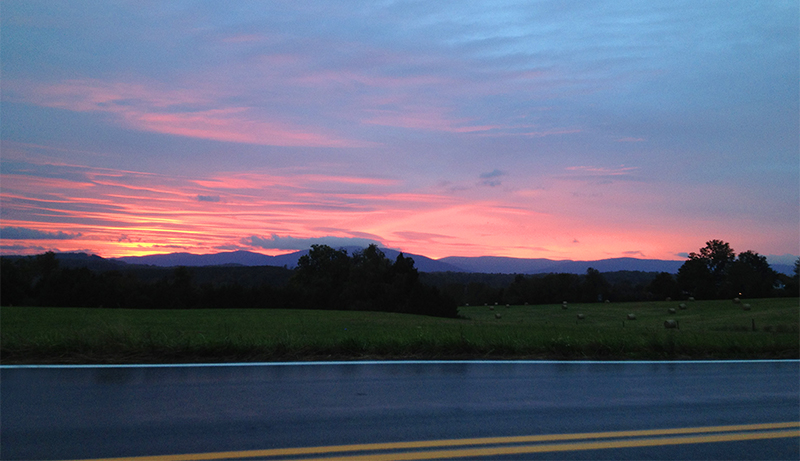October 26th, 2013 §
The 2013 growing season came to an end last night with the first freeze of the fall. When I woke up this morning, it was 26 degrees and the ground was covered in thick white frost. 
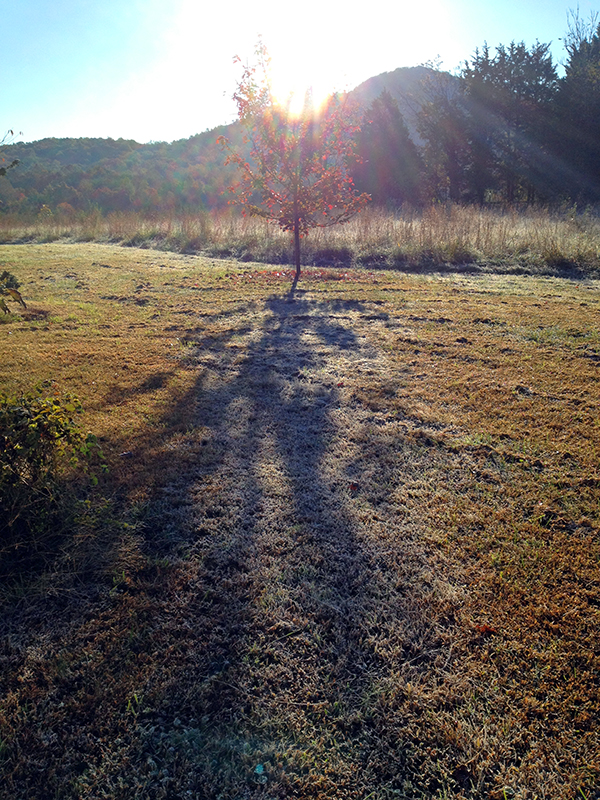
A brisk walk around the farm revealed blackened and sagging flowers, mottled and falling leaves, and the last of the garden peppers reduced to mush inside skin. It is always, for me, the saddest morning of the year. It means no more digging in the dirt and no more daily joy watching my labor become food and flowers. Now all that’s left to do is tear out the dead plants and drag them to the compost pile.
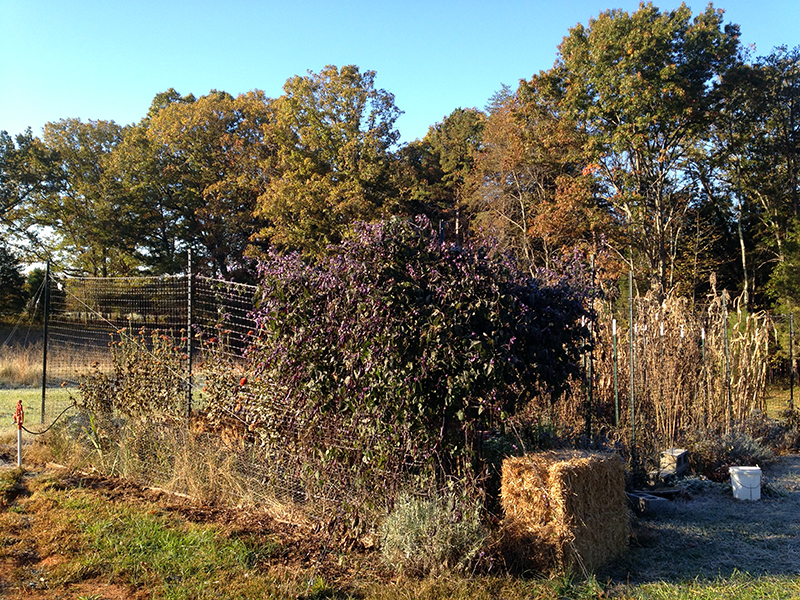
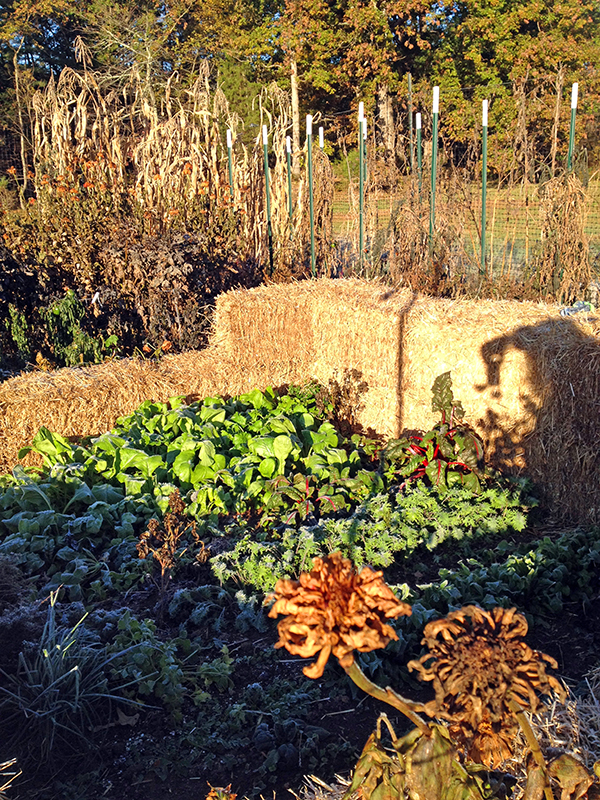
I suppose the only saving grace of this inevitable transition is that it’s now woodstove season. I made my first fire this morning to warm up a 50-degree house. I hadn’t turned my heat on yet this fall, and now it’s up to Jotul to beat back the chill. The stove started right up, drew perfectly, and seems so happy to be back to work and the center of attention. It is the warm white heart of this home.
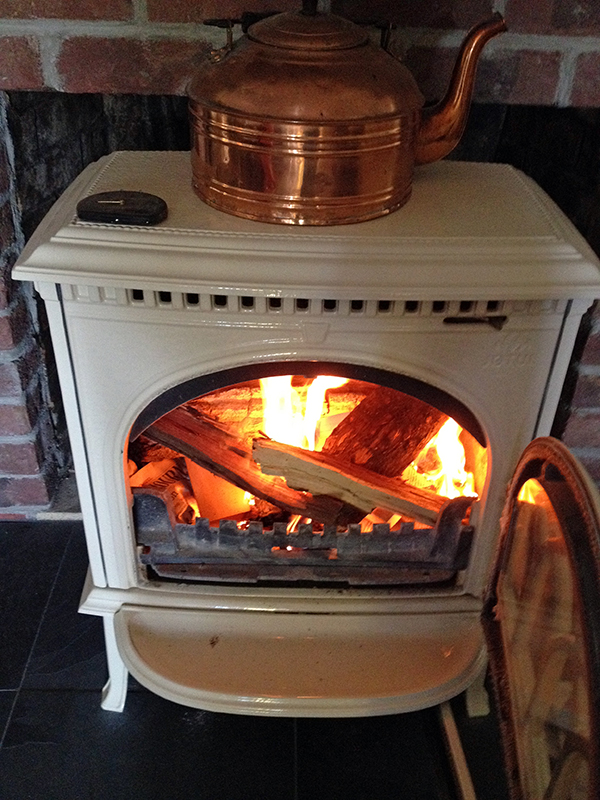
I’ll be back soon with the 2013 garden success and failure post, as well as more info on all sorts of projects that I didn’t get a chance to write about during the busyness of summer. But now it’s time to go put another log on the fire.
October 18th, 2013 §
It’s the time of the year when the sky and lowering angle of the sun start to do very interesting things with light and shadows. The leaves are not yet turning en masse, but it won’t be but another week or so before the mountains are red and gold. Fall. I hope you’re out and enjoying it in your favorite way.
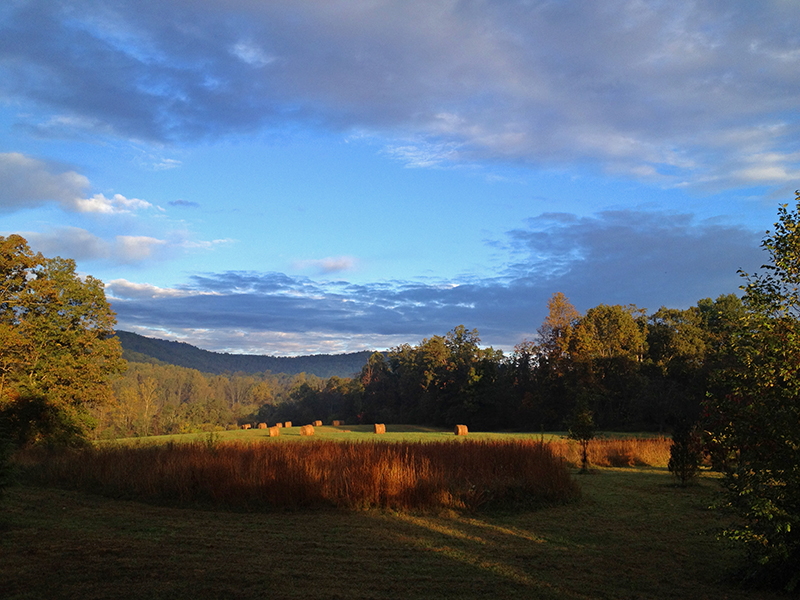
October 16th, 2013 §
I found this lone monarch feasting amongst the zinnas last week. Given all the trouble monarchs are in, I was very happy to see it and to know I’d done my part to cultivate a delicious banquet of nectar-rich flowers. I wonder if this butterfly was refueling on its migration to Mexico?
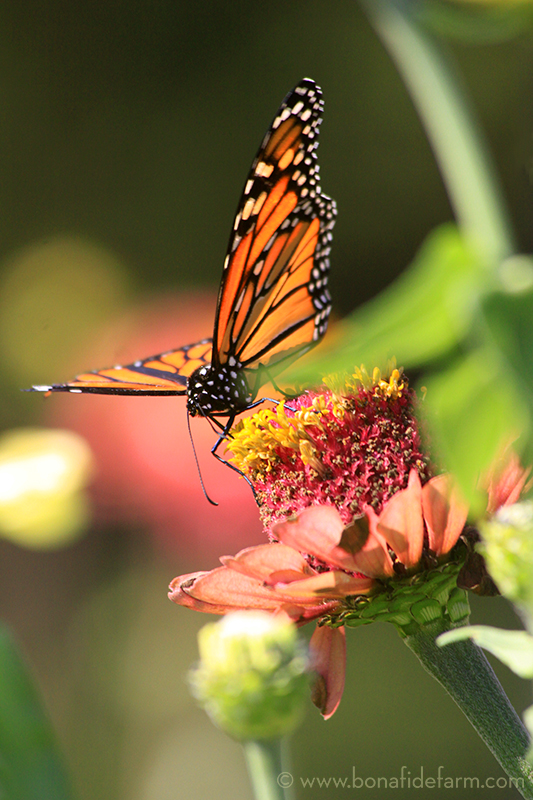
Monarch butterflies are decreasing at an alarming rate: 59% in the last year according to a survey carried out during the 2012-2013 winter season by the WWF-Telcel Alliance, and Mexico’s National Commission of Protected Areas (CONAP). The numbers of monarchs are at their lowest numbers in 20 years. According to the same organization:
The latest decrease in monarch butterflies is likely due to a decrease in the milkweed plant (Asclepias) – a primary food for monarchs – from herbicide use in the butterfly’s reproductive and feeding grounds in the US, as well as extreme climate variations during the fall and summer affecting butterfly reproduction.
Why should you care if monarch numbers are decreasing? Because monarchs, like all insects, are pollinators. In simplest terms, without pollinators we won’t have any of the foods that require pollination, no fruits or vegetables, and these are the healthiest foods we can eat. And even a food that doesn’t appear to be a vegetable, such as bread, starts life as a plant that probably needs to be pollinated.
So if we want to keep eating, we have to cultivate what pollinators need to thrive and eliminate the use of what’s killing them—pesticides and herbicides. In the case of the monarch, their most important food is milkweed. There are some native milkweeds in this area, and one of the reasons I don’t mow some of my fields is to let these “weeds” flower to feed the monarchs. Even so, these butterflies need more milkweed. It’s one of my goals to some day make a formal monarch garden, rich with milkweeds, to try to encourage monarchs to breed and cocoon right here.
If you’ve never seen a monarch cocoon in person, it’s worth planting a butterfly garden just for a chance to spy this treat. The cocoons are the most beautiful color of Jadeite green and are decorated with spots of pure, shining gold. They look like precious jewels. When the monarch is about to hatch, the cocoon turns translucent and you can see the orange and black butterfly folded up inside. When it emerges, it’s all wet, sticky and deflated, and it must sit and slowly pump its wings until its blood inflates them. Truly fascinating and beautiful to watch in person.
For even more on the monarchs, visit monarchwatch.org. And for a scientifically literary take on the monarchs’ plight, read Flight Behavior, by Barbara Kingsolver, one of my most favorite authors.
October 15th, 2013 §
After harvesting more than 100 ears of ‘Glass Gem’ corn, I needed to do something with it. A harvest wreath was the perfect project. I love to make wreaths—I love the seasonal symbolism of them and the way they act as jewelry for the house, dressing it up in a way that shows that the person who lives there cares enough to make the public face of their home pretty and welcoming.
However, the wreaths one most often encounters in stores are all too frequently plasticly hideous, reminding me of cheap gravestone decor, while being simultaneously, ironically expensive. It’s very hard to find a good wreath, which in my definition is one that looks natural and fairly understated, while also having enough going on to be interesting. The wreath should also be complementary to the home that it’s decorating.
Because I am picky about wreaths, I tend to make my own each season. I’ve done fall fruit wreaths, winter greens wreaths and spring wildflower wreaths, but I’d never before attempted an Indian corn wreath. It was a bit of a learning curve, but here’s how it all went down.

I got a few cheap wire wreath frames, and then I set to work sorting my best-looking ‘Glass Gem’ corn by length into separate buckets. I figured I had enough good corn for two fairly substantial wreaths. Then I did a test fit for the first wreath, choosing the ears for the four cardinal directions and then filling in between them with a nice balance of colors.
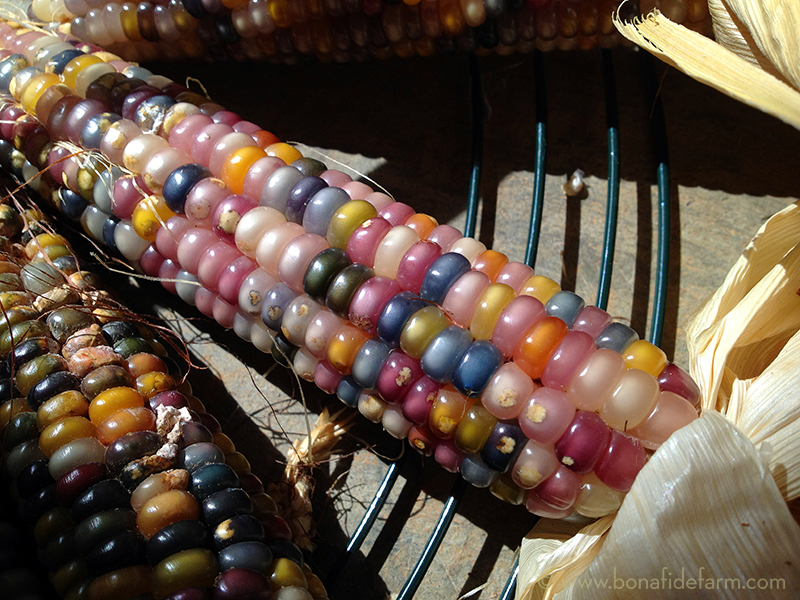
I soon realized that the corn wasn’t thick enough to totally hide the wire frame. I did two things to fix this issue. First, I wired some pieces of rafia sheeting, which were actually cut-up IKEA window screens that I’d had for many years, to the wire base. Second, I folded a few pieces of corn husk back behind each cob, trimming the husk that stuck out past the end of the cob.

After I hot glued each ear down, they still needed more support to stay on the frame. I had to make two points of connection on each ear to keep them from flopping around or falling off when the wreath was hung. I got a big needle and some very fine gauge wire and sewed each ear onto the frame, going around twice. The silver wire blended in pretty well and wasn’t too noticeable. I tied the wires off in the back of the wreath, leaving them long enough that I could tighten them again should the corn shrink as it dries.

And then I just kept going, glueing and wiring the corn in place, all while sitting on the floor of the garage.
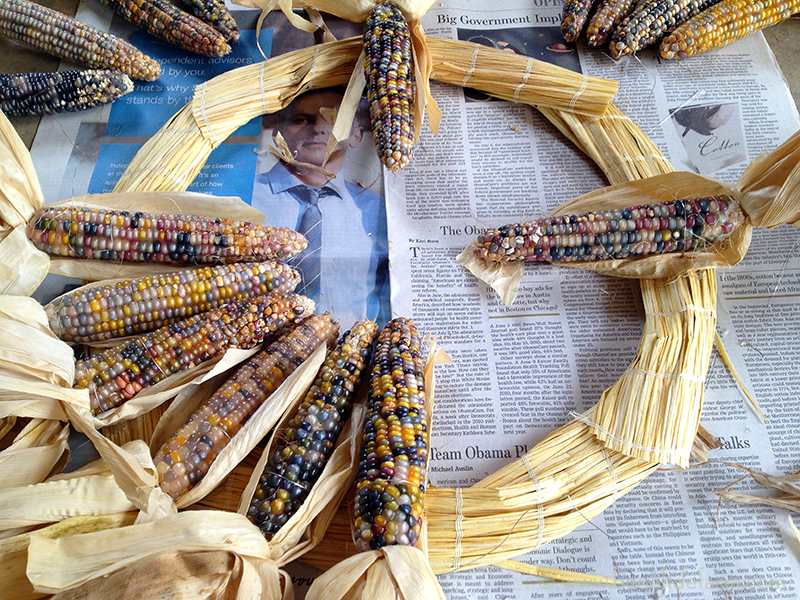
It took a long time to fuss with each piece to make it look nice, but I had lots of company.

In fact, the chickens seemed pretty happy to be snacking on runaway ‘Glass Gem’ corn kernels. What a gourmet treat!

Once I got all the corn cobs attached, I went back and filled in some thin-looking spots with extra corn husk. Some of cobs had lost their husks entirely, so I hot-glued prosthetic husks to them. And then I got some wheat stems (picked up at the craft store) and glued them in between each cob for another layer of interest. I trimmed the tips of some of the cobs with my pruners to help make the negative space in the center of the wreath as even as possible.
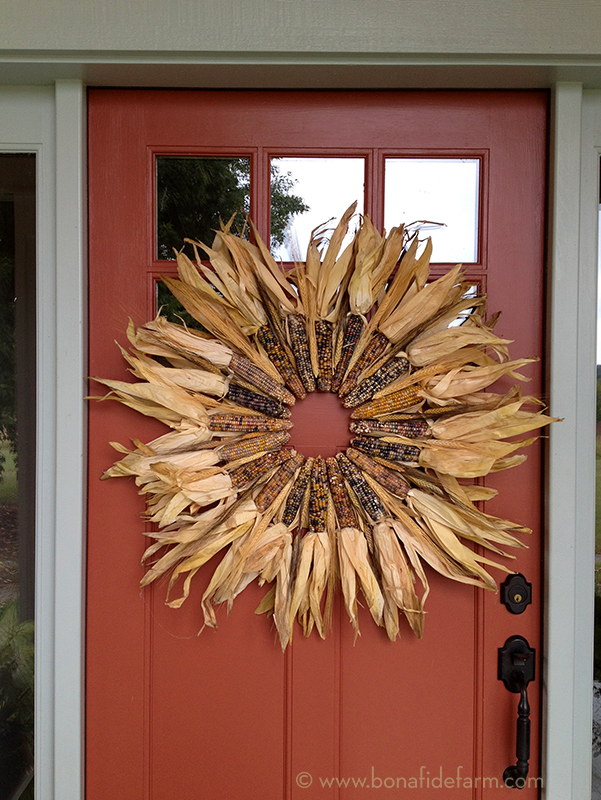
After a test-hang to check for any weird-looking spots, the wreath was ready for the front door. I couldn’t have picked better corn colors to go with my house!
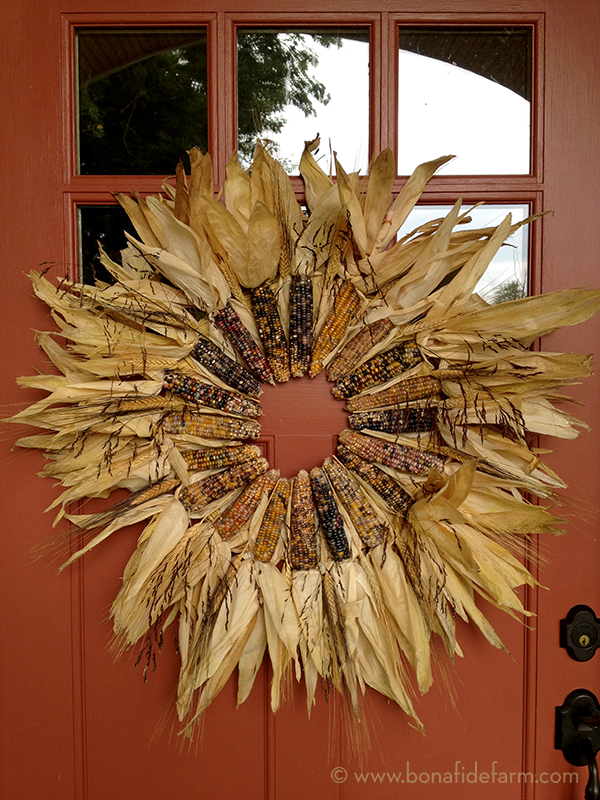
And then I made another for wreath for my mom’s front door. The wreaths have been hanging almost a month and seem to be holding up pretty well. They’re both on protected porches, which I am sure helps to extend their life. But if they should decide to take a turn for the ugly, I know a bunch of chickens that would be pretty thrilled to help dispose of the remnants of my harvest wreath.
October 14th, 2013 §
It’s been raining and grey here for about the past week. There are three inches of rain in the gauge, all collected during the last few days. It feels like the sun will never shine again.
So, let’s look at something bright and colorful today. My dahlias are coming into their prime season, mid-October, and the extra rain is making them especially happy. I picked an assortment a few days ago to make a record of how these named varieties performed in my garden.
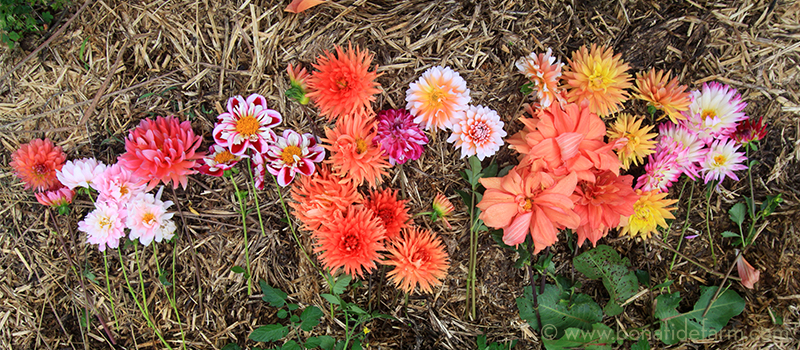

Above, from left to right: ‘Fire Magic,’ pale pink and white ‘Chilson’s Pride,’ Unknown—possibly ‘Fire Magic’ again, the very cool raspberry and white collarette ‘Bumble Rumble’
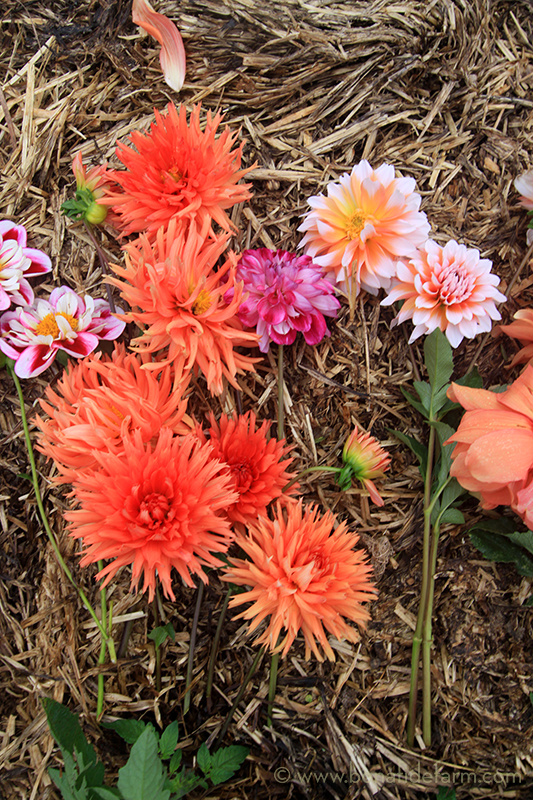
Above, from left to right: ‘Bumble Rumble,’ orange ‘Kabloom,’ purple ‘Optic Illusion,’ orange and white ‘A la Mode’

Above, from left to right: ’A la Mode,’ huge coral ‘Mango Madness,’ unknown yellow and unknown purple and white from hardware store grab bag
‘Kabloom’ has really stood out this year. Not only did it overwinter from last year, it was the first to flower and grew taller than me. Of course I should have pinched it, but I didn’t. Thus, it’s fallen over now but still continues to pump out these spiky orange blooms.
I really love the color, size (11″), and blowsiness of ‘Mango Madness,’ but its blooms are quick to fall apart.
Although all these dahlias are pretty, in general I think the previous two years were better dahlia years. Perhaps dahlias, being native to Mexico, didn’t appreciate our very wet, humid and relatively coolish summer. I had my first case of powdery mildew show up in the dahlias this year. And, I know they were too crowded in the garden. Everything was—that’s what happens when you decide to grow a corn patch and expand the dahlia planting in the same year. Some of my favorite dahlias from year’s past didn’t make it through the winter—their tubers got too dried out and died. So, I missed those this year but one of the most exciting things about growing dahlias is trying new varieties each season.
I am torn about whether to dig up these tubers and overwinter them indoors (properly this time, so as to not lose as many as last year) or let them overwinter in the ground. I suspect that if they stay in the ground they will get growing sooner next spring, but I also run the risk of losing them to the damp and cold. And, if I run the chickens in the garden again this winter, the birds may scratch and peck the tubers into oblivion. I haven’t decided yet—we’ll see. But in the meantime, and for these last few weeks before the first frost, I will be enjoying these bright and favored flowers.
October 12th, 2013 §
Apparently, I collect paint cans. And this doesn’t even count all the exterior paint stored in the garage!
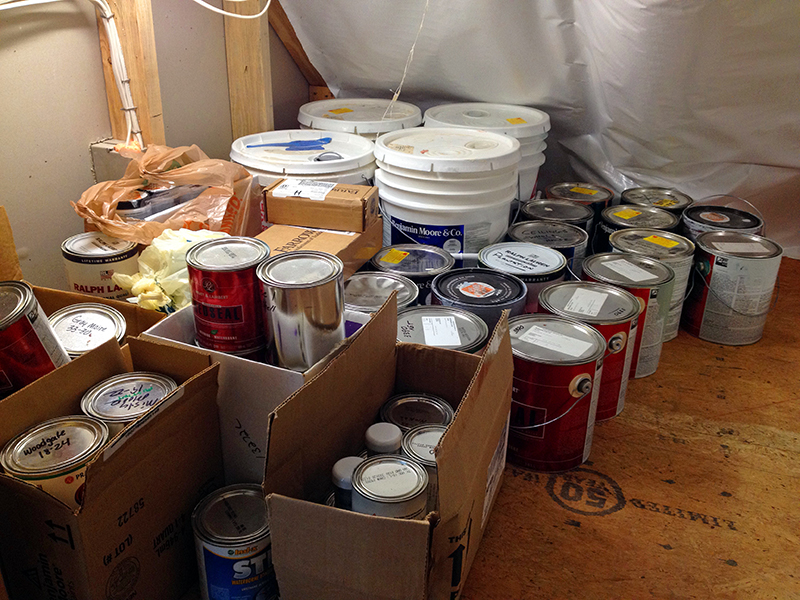
I had a crew here this week spraying foam insulation in all of the six under-eave cubby holes that I use for attic storage on the second floor. My hope is that the insualtion will help seal the mice out, as well as the cold air that was streaming into the house from these unfinished spaces that were, until this week, fairly open to the outside.
I had to take everything out of the cubbies for the guys to work in them, and yesterday while I was putting it all back I was a bit shocked to realize how many cans of paint I have collected. This is what happens when you’re obsessed with paint colors and you’ve painted certain rooms more than three times within three years of living in a house to get just the perfect shade. I blame twelve years of apartment living–in which I was forced to suffer with regulation dingy-looking off-white walls—for inducing this paint-bingeing behavior!
October 11th, 2013 §
October 7th, 2013 §
I was on the couch yesterday morning when I heard a loud thump outside. Tuck barked. I ignored it. Then I heard another thump, and Tuck got up and went to the front door, where he went crazy, growling and barking and whining. Of course I got up and when I looked out the front door, I saw my neighbor’s two horses at the end of my front walk. Looks like my neighbor had forgotten to close her gate and they’d escaped, again.
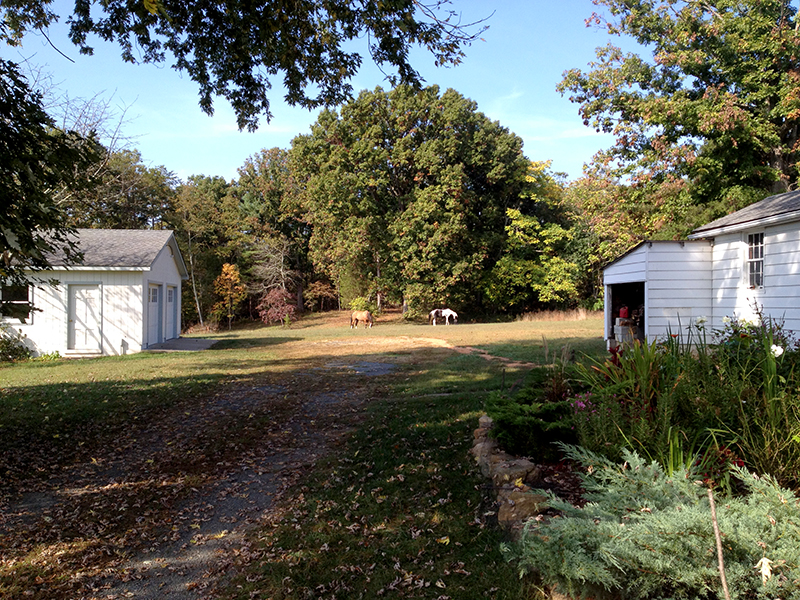
I knew my neighbor wasn’t home. While I called both her numbers and just got voicemail, the horses made their way to the back field by the garage. For the next hour or so I kept an eye on them to make sure they didn’t head for the road, and I waited for my neighbor to call to say she was on her way over to capture them.
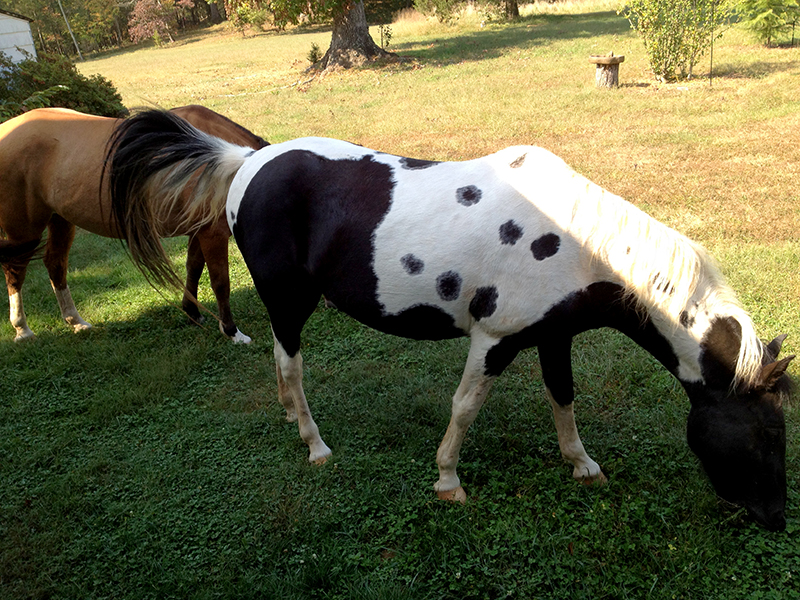
Well, I was still waiting when the horses came up around the house garden and started to nibble my landscaping. When one of the horses shoved his muzzle into a container of just-sprouted lettuce, smushing the baby plants into a pulp, I got a bit annoyed and realized that if I wanted my plants unscathed I would need to remove the horses. Easy, right?
Except I am at best uncomfortable around horses, and at worst very afraid of being near them without a fence in between us, especially when I am all by myself. I have had enough scary experiences around and on horses that I don’t really feel the need to hang out with them ever again. But I had to do something, not only to save my garden but also any unsuspecting motorists that might be driving up the road when one of these horses got an idea to bolt.
When another neighbor had captured these horses the first time they escaped, she led one by looping a huge horse rope around its neck. And horses, being herd animals, will tend to follow each other. If I could get one horse home odds were the other would follow. Only trouble is I didn’t have a rope that was stout enough to lead a horse. So I grabbed Tuck’s longest, heaviest leash and hoped it would hold.
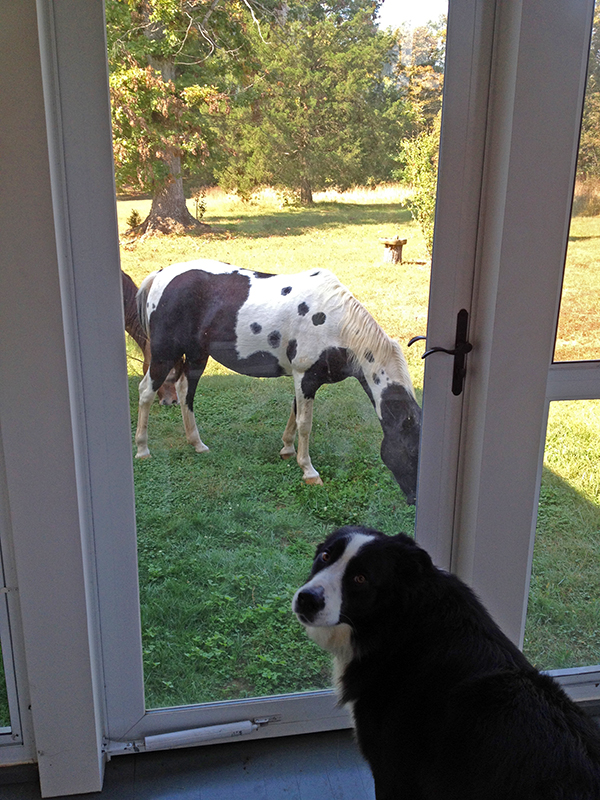
Tuck was still going nuts on the porch, his order-loving mind just blown by these very large, very alive, and very out-of-place creatures that had suddenly appeared in his domain. Something was. not. right, and with every language he had Tucker voiced his concern, eyes round as saucers and ears pinned back flat to his head.
While Tuck paced and whined and watched with the most consternated expression I’ve ever seen him make, I offered the black and white horse a couple of placating carrots as I gingerly petted his head. Then I looped the leash around his neck, holding both ends in my fist, and started pulling him toward home. It took some persuading—the appeal of lush new grass is high—but I got him moving. I had to walk with my hand basically against his neck because the leash way too short to properly lead a horse. But I got him going at a pretty fast clip and held his head up so he couldn’t dally and snag more grass. This put me walking uncomfortable close to him, but I just tried to stay aware and away from any of the parts that could kick me, rear up, smash me against the fence, or otherwise bash in my skull, which was feeling very tiny and exposed next to this giant mass of twitchy muscle.
I got the horse all the way home and into the gate by his barn, which sure enough was open. I had to push him pretty hard to get him through, as he didn’t want to leave his freedom. The brown horse had galloped along side of us, frolicking in the newly hayed pasture. Unfortunately, he didn’t follow his buddy into the gated pasture, and instead headed further out to graze. I knew he was the more spirited of the horses, according to his owner, and he’s also bigger, so I had to steel myself to approach him.
I got the leash around his head and had to pull with all my might to get him to stop eating grass. It must have been a pretty silly scene, me trying to move a stubborn horse with what amounted to a shoelace. But after digging my heels in I got his head up and got him moving along toward the gate. He tried a few more times to stop to graze, but something about my militant march must have made him realize I meant business. I got him in the gate, where he and his friend kicked up their heels and laughed at their little adventure as they took a victory gallop around the field. Then I went home, left my neighbor a message that I had gotten her horses in, and spent the next two hours shaking from all the adrenaline that had just flooded my body. And I have to say, this little experience emphatically confirmed that I prefer my horses as beautiful lawn ornaments in my neighbor’s field, with the gate firmly latched.
October 5th, 2013 §
This lovely fuzzy white caterpillar came in on a bunch of dahlias. I’m not 100% positive on the i.d. Correct me if I’m wrong.

October 2nd, 2013 §
I took my tablecloth out of the dryer this morning and was dismayed to find it torn. Two big gashes where the heavy cotton jacquard had split open. I sighed, sensing that its day had come and it was now worn out. I’d been dreading this moment.
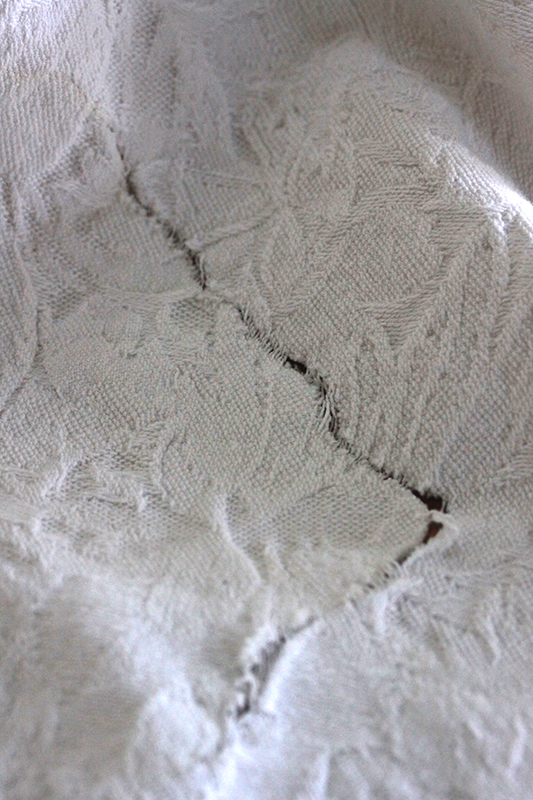
I have had this tablecloth for 11 years. My mom bought it for me at a Crate and Barrel outlet when I was setting up an apartment in San Diego, and it’s traveled with me to every house since. On one corner it bears slubs from the claws of a maniacal white kitten that briefly haunted my life, but other than that the abuse of daily life has barely marred it. And it’s not like I treat it as one ought a lily white piece of fabric. Instead, it faces down dirty garden produce, spilled wine, festive splatters, and every sort of dirty creative thing I have going on at any given moment. And it always washes up just fine with no special treatment.
It’s because of this resiliency that I am very fond of this piece of fabric. That, and its thick, soft, comforting texture in the perfect shade of white, and its pure cotton quality that’s almost impossible to find these days for less than several hundred dollars.
Further inspection revealed that the fabric hadn’t worn through. Very strangely, it split open right along the edge of a very faint, almost invisible stain. I have no idea what the stain was, and hadn’t noticed it when the cloth was on the table. It sounds crazy but there seems to have been some sort of chemical reaction that ate through the fabric. Has anyone ever heard of this? I hadn’t used bleach in the wash, just regular detergent and a white vinegar rinse. It was in the wash with a bunch of towels, so no buckles could have torn it.

Regardless of how the tears were created my affection for this tablecloth was enough to try to patch it up. I am no seamstress, but I gave it a go. It was gentle, quiet work that was fitting for my energy level. I’ve just spent three days with a stomach bug unlike any I’ve ever experienced. The doc thinks it was viral, or food-related, but the bottom line, other than the obviously biological, was fevered nights, chilled days, 72 hours without eating, four pounds lost, ongoing gorgeous birdsong outside the window, dinner and concert plans cancelled, two contractor visits for home improvements rescheduled in the midst of big projects, the weight of my sleeping cat anchoring me in my body, and many Netflix movies streamed in bed.

Two hours of sewing later and I had created some meandering seams that brought to mind raised surgical scars. I am sure a Colonial four-year-old would have done better, but I don’t mind the patch job.
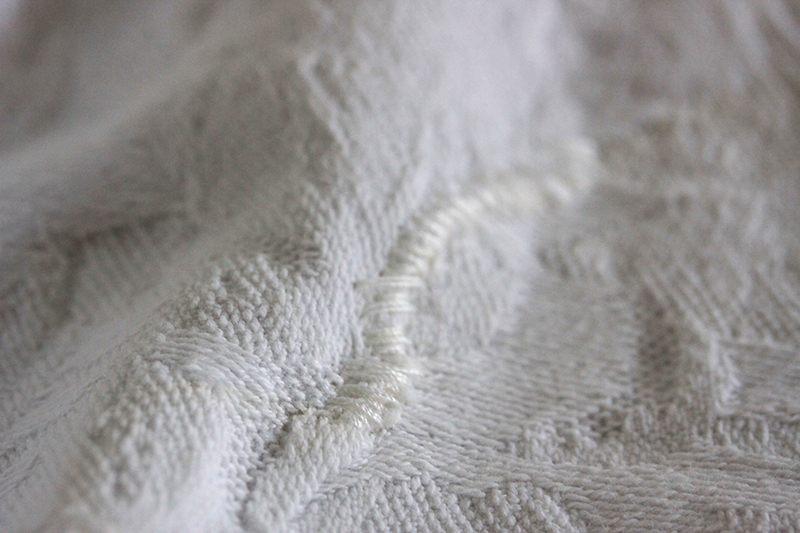
The thread I had wasn’t a perfectly matched shade of white, but no one but I will ever notice that. In fact, I doubt many people will notice these repairs at all as they blend pretty well into the woven texture of the cloth. It will remain our little secret, for hopefully many more years.





















